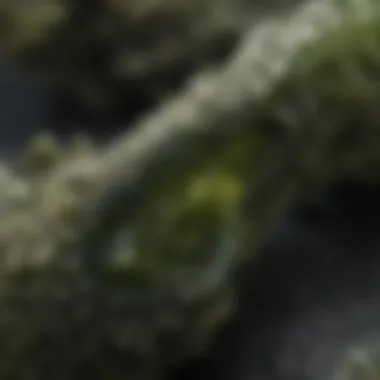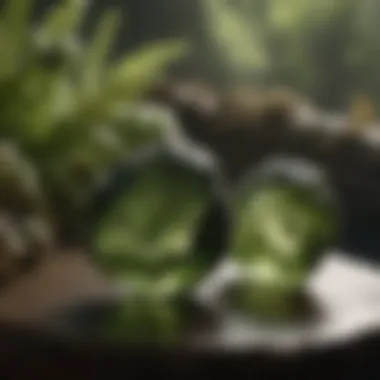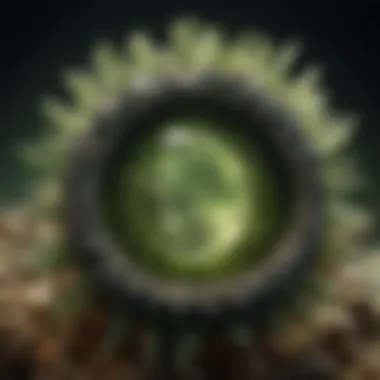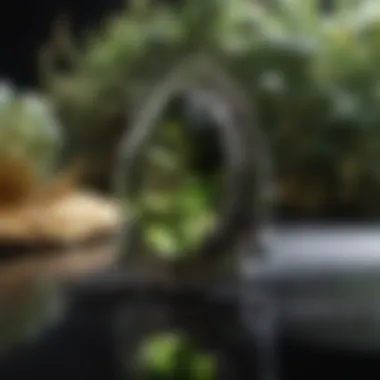How to Identify Authentic Moldavite Effectively


Intro
Understanding the authenticity of moldavite is a pursuit that many gemstone enthusiasts and collectors embark upon. Moldavite, formed by the impact of a meteorite in the Czech Republic nearly 15 million years ago, holds a unique allure due to its scarcity and the distinct beauty it often portrays.
However, the rise in demand for moldavite has led to an increase in counterfeits on the market. Consequently, identifying genuine moldavite is crucial for anyone looking to add this captivating gemstone to their collection.
This article aims to provide an in-depth exploration of how to determine the authenticity of moldavite. We will dive into its characteristics, how to differentiate it from fakes, and discuss the methods used to verify its genuineness. As we progress, readers will gain valuable insights into the market trends and considerations vital for making informed purchases.
Gemstone Overview
Definition and Characteristics
Moldavite is a type of natural glass that is classified as a tektite. Its formation is linked to the extreme heat and pressure generated during a meteorite impact. This has endowed moldavite with some distinct features that can aid in authentication.
Some key characteristics include:
- Color Variations: Genuine moldavite usually exhibits a range of colors from olive green to bottle green, sometimes with darker or lighter shades.
- Textural Qualities: Authentic moldavite often shows a unique texture with pitting and striations that mimic the effects of air bubbles during the cooling process.
- Transparency Levels: Moldavite can vary from transparent to translucent; however, it is usually not entirely clear.
Classification of Gemstones
Moldavite is classified under two main categories of gemstones: natural and synthetic. Natural gemstones are created through geological processes, whereas synthetic alternatives are manufactured in labs.
Because moldavite is a natural gemstone, understanding its classification helps potential buyers recognize the values associated with different types. Valuing moldavite involves considering factors like rarity, origin, and the market's current demand.
"Moldavite's allure is not just in its beauty, but in the story it tells of our planet's history."
Historical Significance
Ancient Uses and Cultural Importance
Moldavite has captivated human interest for centuries. It is believed that ancient cultures, including the Celts, considered moldavite to have spiritual significance, often using it in rituals or as talismans.
This gemstone's historical relevance is noteworthy, especially in the context of its use in various crafts and ornamentation. Its unique origin and aesthetic properties have made it a coveted item in both ancient and modern society.
Myths and Legends Surrounding Gemstones
Various myths and legends have arisen around moldavite over the years. Some believe it possesses mystical powers that can enhance intuition and spiritual transformation. These notions contribute to its allure among collectors and enthusiasts. While the scientific evidence supporting these claims may be lacking, the stories attached to moldavite enhance its value in the collector's market, adding an extra dimension to its significance.
In summary, understanding moldavite's attributes and historical importance is critical in recognizing its authenticity. As we move forward in this article, we will explore practical methods to ascertain whether your moldavite is real.
Prelims to Moldavite
Moldavite has gained immense popularity among gemstone enthusiasts and collectors due to its unique origin and intriguing properties. The rise of interest in this extraterrestrial glass has prompted a need for understanding its authenticity. With the increasing presence of counterfeit products in the market, knowing how to assess the veracity of moldavite becomes crucial. This knowledge not only protects consumers’ investments but also fosters appreciation for this remarkable stone.
A fundamental grasp of its definition and origin sets the stage for deeper exploration. Understanding where moldavite comes from, historically and geologically, can aid one in identifying genuine pieces from imitations. This connection to history enriches the experience of owning moldavite, as many are drawn to its story rooted in the cosmos.
Moreover, moldavite's increasing market value and demand require careful consideration for visual identification and testing. As you delve into the specifics of moldavite's properties, being well-informed about its significance will empower you to make sound purchasing decisions.
In the following subsections, we will dissect the origins of moldavite and highlight its historical importance. This foundational knowledge will serve as a springboard into recognizing its unique characteristics, thereby ensuring authenticity.
Understanding Moldavite Properties
Understanding the properties of moldavite is essential for anyone looking to assess its authenticity and value. This knowledge forms the foundation for effective identification of genuine specimens. Moldavite's unique characteristics make it a highly sought-after gemstone, yet these same traits can also lead to confusion and counterfeit products in the market. Knowing what to look for in terms of both physical and chemical attributes can save buyers time and money while ensuring a satisfying investment in this distinctive gemstone.
Physical Characteristics
Moldavite is notable for its distinctive physical characteristics, which set it apart from other gemstones. When examining moldavite, one should pay attention to several key factors:


- Color Variations: Authentic moldavite typically exhibits a rich green hue, though it can range from pale green to almost black. This color arises from its unique origin, as moldavite is formed from a meteorite impact. One may find lighter or darker areas in a single piece, which is a sign of genuine stone.
- Surface Texture: The surface of real moldavite is often etched with a distinctive pattern called "flow lines." These include grooves and pits which result from its rapid cooling after forming in a high-temperature environment. If a piece appears overly smooth and polished, it may not be authentic.
- Inclusions: Moldavite can contain inclusions, such as gas bubbles or tiny fragments of other minerals. These features further authenticate a piece. A piece without any imperfections or anomalies is likely to raise suspicion about its authenticity.
In summary, observing the physical characteristics of moldavite enhances the buyer's ability to discern between genuine stones and fakes. Taking the time to closely inspect these features is a crucial step in ensuring a wise purchasing decision.
Chemical Composition
The chemical makeup of moldavite contributes greatly to its identification as a genuine gemstone. Moldavite is a type of tektite, primarily composed of silica, aluminum, and other trace elements. An understanding of its chemical composition can be beneficial for serious buyers, as this knowledge adds depth to the evaluation process.
- Silica Content: Moldavite has a silica content of approximately 70%, similar to that of glass. However, its unique formation process gives moldavite distinct properties that differentiate it from typical glass.
- Trace Elements: Recognizing the presence of certain trace elements, such as gallium, vanadium, and titanium, can also play a role in authenticating moldavite. These elements occur in extremely low concentrations, making their presence in a sample a strong indicator of authenticity.
- Unique Fingerprint: No two pieces of moldavite are identical at a chemical level. Each piece holds its distinct "fingerprint" determined by its origin and the geological process it underwent, further aiding in identification.
Understanding the chemical composition not only aids in confirming a moldavite's authenticity but also enriches one's appreciation for the gemstone itself.
Identifying Authentic Moldavite
Identifying authentic moldavite is a crucial aspect of purchasing and owning this unique gemstone. As moldavite gains popularity, counterfeit versions flood the market. Therefore, it is essential to discern genuine moldavite from imitations or synthetics. Understanding how to identify authentic moldavite can prevent financial loss and preserve the integrity of one's collection.
Visual Inspection
Visual inspection serves as the initial step in identifying authentic moldavite. Through careful examination, one can detect distinguishing features that separate genuine stones from counterfeits.
Color Variations
Color variations in moldavite are apparent and range from deep green to a lighter olive hue. The gemstone may exhibit an inner glow, which is characteristic of its natural formation from a meteorite impact. The key element of color variations is that these hues should be somewhat translucent, not opaque. This quality makes it easier to verify authenticity when compared to solid colored glass imitations. Nevertheless, the presence of color variations can sometimes make it difficult for inexperienced buyers to determine authenticity.
Surface Texture
The surface texture of authentic moldavite is another distinguishing feature. Genuine moldavite typically has a distinct etching or wrinkled texture, which is a result of its formation in high-temperature conditions. This unique surface characteristic differentiates it from smooth glass replicas. Buyers should look for these textures and avoid stones that feel overly polished or entirely smooth, as they could be imitations.
Inclusions
Inclusions are imperfections within the moldavite that can indicate authenticity. Genuine moldavite often contains gas bubbles, minerals, or other natural inclusions formed during its creation. These inclusions help tell the stone's origin story. They add value and authenticity. However, the presence of inclusions can be a double-edged sword for buyers, as some might perceive them as flaws rather than valuable characteristics.
Weight and Density
Weight and density provide another layer of verification for moldavite. The gemstone appears lightweight for its size, which is an important aspect when determining authenticity. Knowing these differences can help in making an informed purchase.
Using a Scale
Using a scale to measure moldavite can provide insight into its authenticity. Moldavite typically has a specific weight relative to its size, which can be compared against known metrics. Understanding this factor is beneficial because it places a tangible metric on the evaluation process. However, casual buyers may not possess the precise tools needed to get accurate weights, which can limit this method's effectiveness.
Comparative Analysis
Comparative analysis compares the moldavite in question with known authentic stones. This method helps potential buyers identify discrepancies in weight and size. Utilizing this analytical approach offers reassurance when evaluating authenticity. However, this requires access to verified stones, making it less accessible to average consumers.
Always remember that while visual inspection and physical characteristics help, seeking professional advice or testing is advisable for absolute certainty.
Advanced Testing Methods
When assessing the authenticity of moldavite, advanced testing methods play a crucial role. These methods provide deeper insights beyond simple visual inspections or weight checks. Utilizing professional appraisal and scientific laboratory tests ensures that buyers can make informed decisions. In a market flooded with counterfeit options, relying on reputable testing can safeguard investments and enhance the value of genuine moldavite in collections.
Professional Appraisal
A professional appraisal involves an expert examining moldavite using their knowledge and experience. Appraisers can identify specific features that indicate authenticity, such as the unique textures and forms characteristic of natural moldavite. Their insights are invaluable, especially for those unfamiliar with the mineral world. Professional appraisers often provide documentation that adds value and credibility to the authenticity assessment.
Laboratory Tests
Laboratory tests offer a scientific approach to confirming moldavite's authenticity. These methods are precise and can detect subtle characteristics that may not be visible to the naked eye.
Spectroscopy


Spectroscopy is a powerful technique used to identify the composition of materials. This method analyzes how moldavite interacts with light, providing information about its chemical makeup. The key characteristic of spectroscopy is its ability to detect specific wavelengths absorbed or emitted by the material. This makes it a beneficial choice for assessing authenticity because it can differentiate genuine moldavite from synthetic or altered stones.
A unique feature of spectroscopy is its non-destructive nature; the test does not harm the stone. However, it requires access to specialized equipment, which may not be readily available to the average buyer. Its main advantage lies in its accuracy, which significantly enhances the buyer's confidence in their purchase.
Microscopy
Microscopy involves using magnification tools to closely examine the physical features of moldavite. This method allows for the observation of inclusions and surface textures that are characteristic of genuine material. The key characteristic of microscopy is its ability to reveal details invisible to the naked eye. This can provide proof of the moldavite's natural origins.
One unique advantage of microscopy is that it allows buyers to see the internal structure of the gemstone. However, similar to spectroscopy, it requires expertise to interpret the findings accurately. While microscopy is effective, the requirement for skilled analysis can be a barrier for some individuals. Nonetheless, its ability to validate the authenticity of moldavite makes it an essential tool in the overall assessment process.
Common Counterfeit Types
Understanding the various types of counterfeit moldavite is vital for anyone interested in acquiring this unique gemstone. With the growing popularity of moldavite, many counterfeit versions have appeared on the market, leading to confusion among buyers. Recognizing these counterfeits not only saves money but also ensures an authentic experience when collecting or utilizing these stones.
Synthetic Moldavite
Synthetic moldavite is a man-made alternative that shares some visual characteristics with real moldavite but is produced through artificial processes. This creates significant concerns as synthetic stones can be sold at prices comparable to genuine ones, potentially leading buyers to believe they are purchasing authentic material.
The primary method for creating synthetic moldavite involves using high-temperature and high-pressure techniques. While these stones can exhibit shimmering effects similar to authentic moldavite, they lack the natural inclusions and textures that characterize genuine specimens. Often, synthetic moldavite will present a glass-like shine, which can be an immediate red flag.
To identify synthetic moldavite:
- Check for Bubbles: Real moldavite usually contains tiny air bubbles within the stone, while synthetic versions may lack these imperfections.
- Examine the Texture: Synthetic stones tend to have smoother surfaces, contrasting the more varied texture of authentic moldavite.
- Watch for Color Uniformity: Genuine moldavite varies in shade and saturation, whereas synthetic versions are usually more uniform in color.
Glass Imitations
Glass imitations of moldavite represent another common counterfeit type. These are often created using melted glass that is shaped to mimic the appearance of moldavite. They can be crafted in various shades, including the deep greens or olive tones often associated with the natural stone. However, distinguishing glass from real moldavite is crucial as these imitations do not hold any of the geological significance or uniqueness associated with genuine moldavite.
Here are several characteristics to help identify glass imitations:
- Weight Differences: Glass is generally lighter than authentic moldavite. Weighing the stone can provide a quick indication of its authenticity.
- Surface Imperfections: Real moldavite may exhibit natural blemishes and inclusions due to its extraterrestrial origin. Glass stones tend to have a more polished and even surface.
- Burn Test: If you suspect a piece is glass, a simple burn test can help. Authentic moldavite will not produce an odor when exposed to flame, while glass will emit a distinctive smell.
Authenticity is crucial for both collectors and those who appreciate moldavite's unique origin and history. By recognizing these common counterfeits, buyers can make informed decisions, preserving the integrity of their collection.
The Market for Moldavite
Understanding the market for moldavite is essential for anyone looking to acquire this unique gemstone. As it is both valuable and relatively rare, being informed about market dynamics enables potential buyers to make educated decisions about their investments. Knowledge of current trends, pricing factors, and the integrity of vendors can safeguard against unscrupulous dealings and ensure satisfaction with purchases.
Current Market Trends
The market for moldavite has shown considerable fluctuations over the years. Increased interest in this stone, particularly among collectors and enthusiasts, has resulted in a rise in demand. This is partially due to its mysterious origins and the allure of its aesthetic qualities. Factors such as social media influence and the increase in awareness about moldavite have contributed to its popularity.
Investors and consumers alike are more informed about the implications of collecting moldavite. Many enthusiasts are actively sharing their experiences in various platforms, leading to a greater community interest. Consequently, the market is witnessing a diversification of offerings, with various cuts and forms available. However, these trends also mean that potential buyers must be discerning in their choices, as not all products listed are genuine.
Pricing Factors
Several factors influence the pricing of moldavite. Understanding these factors is fundamental for anyone considering a purchase.
Rarity
The rarity of moldavite plays a significant role in its pricing. As it was formed during a meteorite impact around 15 million years ago, the supply is limited. This limited availability elevates its worth in the market. The key characteristic of rarity is its direct correlation with price - the scarcer the item, the higher the demand and price will generally be. This makes moldavite a popular choice for collectors who seek unique pieces.
However, not all moldavite is equally rare. Variations in color, size, and quality can significantly affect a stone’s rarity in the market. Smaller or less striking pieces may be more readily available, while high-quality specimens can command premium prices. Buyers must assess each piece carefully to determine its rarity and, thus, its potential future value.
Quality Assessment
Quality assessment is another crucial factor that influences the price of moldavite. The quality directly reflects the stone's aesthetics, clarity, and overall appeal. A high-quality moldavite stone is characterized by vibrant color and translucency, along with well-defined inclusion patterns, which can be indicative of its authenticity. Buyers often look for these qualities to guarantee they are investing in a legitimate product.


Quality also includes an examination of the stone's overall shape and finish. Well-polished moldavite, for example, tends to be more desirable than rough or unevenly shaped pieces. As a result, it fetches higher prices in the market.
However, quality assessment can be subjective, and it may vary among collectors and vendors. What one individual views as a high-quality piece might not hold the same appeal for another. Therefore, buyers should perform thorough research and perhaps consult with experts to accurately assess the quality of any moldavite they are considering, ensuring their investment aligns with their expectations.
"Informed buyers are the most successful in the moldavite market. Knowledge is your best protection against counterfeit gems."
Combining an understanding of market trends with insights on rarity and quality assessment will empower buyers to navigate the moldavite market competently.
Buying Moldavite: Key Considerations
When it comes to acquiring genuine moldavite, buyers need to approach the market with diligence and clarity. Given the rising popularity of this gemstone, understanding the intricacies of the purchase process is crucial. Recognizing what to look for in a vendor and comprehending the significance of certifications can greatly enhance the likelihood of obtaining authentic moldavite. These considerations not only safeguard your investment but also elevate your overall purchasing experience.
Choosing Reputable Vendors
Selecting a trustworthy vendor is perhaps the most pivotal step when buying moldavite. An established vendor often provides a wealth of information about their sourcing practices and the authenticity of their inventory. Explore vendors who specialize in gemstones or have a notable history in the industry.
Consider the following aspects:
- Reputation: Look for online reviews and testimonials that reflect positive customer experiences. Websites like Reddit and specialized gemstone forums can offer insights.
- Transparency: A reliable vendor shares sourcing details. They should be willing to explain where the moldavite originated and its journey to their store. This adds credibility to your purchase.
- Return Policy: Reputable vendors typically offer a fair return policy. This is essential, as it provides buyers with a safety net should the gemstone not meet expectations or prove to be less than genuine.
In summary, choosing a reputable vendor mitigates risks and enhances buyer confidence in the authenticity of the moldavite.
Reading Certifications
Certification is a significant indicator of a moldavite’s authenticity. Many sellers provide certifications from recognized gemological institutions, which validate the stone's origin and characteristics. Understanding these certificates is essential for any serious gemstone enthusiast.
Key elements to consider when examining certifications include:
- Gemological Institution: Certifications from reputable institutions like the Gemological Institute of America (GIA) carry weight. Ensure that the certification is from a recognized and respected authority in the gemstone industry.
- Details Provided: A thorough certificate should include information about the moldavite’s characteristics, including clarity, color, and any detectable inclusions. This detail solidifies the trustworthiness of the gemstone.
- Verify Authenticity: Many certifications come with unique identification numbers. Use these to independently verify authenticity through the certifying authority's website.
Reading and understanding certifications is a vital skill for buyers. It ensures that you make informed decisions, investing in real and valuable pieces of moldavite.
Caring for Your Moldavite
Caring for your moldavite is essential to maintain its beauty and authenticity. This unique gemstone, formed by a meteorite impact, is delicate compared to many other stones. Improper care may lead to scratches or loss of luster, ultimately affecting its value. Moldavite requires thoughtful handling and appropriate environmental conditions.
Cleaning Techniques
Cleaning your moldavite correctly is vital to avoid damaging it. Here are effective methods to clean your stone:
- Use Warm Water and Mild Soap: Create a solution of warm water mixed with a few drops of mild soap. Gently scrub the surface using a soft cloth or a soft toothbrush. Avoid abrasive materials that can scratch the surface.
- Avoid Harsh Chemicals: Chemicals can harm the stone’s surface. Always check the label before using any cleaning product.
- Drying: After cleaning, pat the stone gently with a lint-free cloth. Avoid air drying, as this might leave water spots.
- Check for Damage: Regularly inspect your moldavite for signs of scratches or chips. If issues arise, consulting a professional is advisable.
By following these cleaning techniques, you can keep your moldavite looking vibrant.
Storage Guidelines
Proper storage of your moldavite is equally important. Here are some guidelines to ensure its safety:
- Use Soft Pouches or Boxes: Store your moldavite in a soft pouch or a designated jewelry box. This helps in avoiding scratches from contact with other stones or hard surfaces.
- Avoid Direct Sunlight: Exposure to direct sunlight for extended periods can fade the color of moldavite. It is recommended to store it in a cool, dark place.
- Keep Away from Chemicals: Ensure that your storage area is free from chemicals or cleaners that could potentially damage the stone.
- Separate from Other Jewels: If you have multiple gemstones, keep the moldavite away from harder stones. The hardness difference can lead to scratches.
Proper care improves the longevity of moldavite and retains its unique appearance. Therefore, it is essential to be mindful of how you store and clean it.
The End
Understanding how to determine the authenticity of moldavite is critical for anyone interested in this rare gemstone. The importance of this topic cannot be understated, as the market has become inundated with counterfeit options that can easily mislead unaware buyers. Authentic moldavite not only carries historical value but also potential investment worth.
In this article, we have covered many aspects involving authenticity, from initial visual inspections to more advanced laboratory tests. Readers were guided through identifying unique physical characteristics of real moldavite, such as its distinct color variations and surface textures. Additionally, the importance of relying on reputable vendors and reading necessary certifications was emphasized.
Moreover, in discussing the various common counterfeit types like synthetic moldavite and glass imitations, we aimed to equip potential buyers with the necessary tools to distinguish the real from the fake. It is imperative to know current market trends and pricing factors to avoid overpaying for a stone that may not hold true value.
Lastly, proper care for your moldavite was discussed, ensuring that holders maintain the beauty and quality of their stones over time. These insights not only help in making an informed purchase but also foster a deeper appreciation for the allure and significance of genuine moldavite in the world of gemstones.
Final Thoughts on Authenticity
Authenticity is key when it comes to moldavite. Given the high value and unique qualities associated with this gemstone, it becomes essential for collectors and enthusiasts to validate their specimens. Taking the time to learn and apply the techniques discussed can yield substantial benefits, ensuring that your collection consists only of genuine pieces. By being vigilant about authenticity, one can enjoy the rich history and beauty of moldavite without falling prey to the evolving market of counterfeits.







